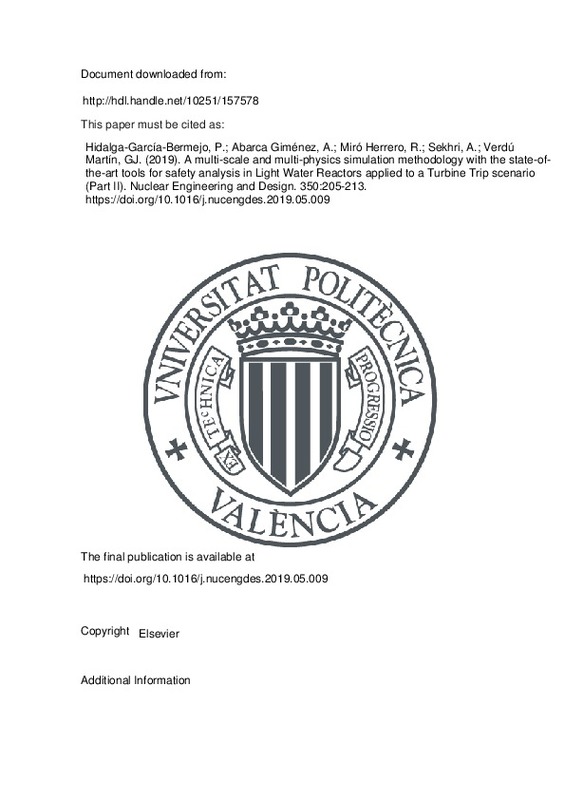JavaScript is disabled for your browser. Some features of this site may not work without it.
Buscar en RiuNet
Listar
Mi cuenta
Estadísticas
Ayuda RiuNet
Admin. UPV
A multi-scale and multi-physics simulation methodology with the state-of-the-art tools for safety analysis in Light Water Reactors applied to a Turbine Trip scenario (Part II)
Mostrar el registro sencillo del ítem
Ficheros en el ítem
| dc.contributor.author | Hidalga-García-Bermejo, Patricio
|
es_ES |
| dc.contributor.author | Abarca Giménez, Agustín
|
es_ES |
| dc.contributor.author | Miró Herrero, Rafael
|
es_ES |
| dc.contributor.author | SEKHRI, ABDELKRIM
|
es_ES |
| dc.contributor.author | Verdú Martín, Gumersindo Jesús
|
es_ES |
| dc.date.accessioned | 2020-12-22T04:32:16Z | |
| dc.date.available | 2020-12-22T04:32:16Z | |
| dc.date.issued | 2019-08-15 | es_ES |
| dc.identifier.issn | 0029-5493 | es_ES |
| dc.identifier.uri | http://hdl.handle.net/10251/157578 | |
| dc.description.abstract | [EN] The development of the computer technology, as well as the research in the different science fields governing the core behavior of a Light Water Reactor, allows implementing all the known physics and consider detailed scales of analysis. Conversely to conservative approaches, the Best Estimate approach applies the available science by means of models and correlations that are applied in different scales using simulation tools. With this approach, the critical elements of the core can be evaluated with realistic predictions that can adjust the operation conditions and core design to more cost-efficient values without compromising the safety of the Nuclear Power Plant. The authors of this paper present the second part of a multi-scale and multi-physics methodology for the evaluation of fast transients in Light Water Reactors. In this part, the results obtained from the coupled Neutron Kinetics and Thermal-Hydraulics channel-by-channel core model are used for a detailed thermal-hydraulic pin-by-pin analysis and thermomechanics pin model. The aim of this work is to evaluate the safety analysis of the critical fuel rod in Turbine Trip scenario. For that purpose, the critical fuel rod is located using the minimum Critical Power Ratio. This safety variable is predicted in a thermal-hydraulic pin-by-pin model using CTF-UPVIS code. Afterwards, the conditions of the critical rod are loaded in a pin model for a simulation with FRAPCON/FRAPTRAN. Moreover, this paper proves the Best Estimate capability of the presented methodology by means of comparing the results with equivalent simulations that are more conservative, or consist of more limited simulation scales. On the one hand, the Best Estimate prediction is compared against the envelope of the minimum Critical Power Ratio along the axial nodal distribution of the simulated fuel rod. In addition, another comparison is made against assuming constant fuel-cladding gas conductance, showing the enhancement added by considering the axial distribution of this parameter, provided by FRAPCON/FRAPTRAN. On the other hand, the results of this methodology are compared against the limitation of accounting only the bundle radial average value of the minimum Critical Power Ratio. Furthermore, the Best Estimate results are complemented with an Uncertainty and Sensitivity analysis that will define the statistical boundaries of the prediction according to the 95/95 criterion. | es_ES |
| dc.description.sponsorship | The authors of this paper acknowledge the technical and economic support of KKL that made possible this project. The acknowledgement is extended to the collaboration of KKL in the research tasks by sharing plant measurements to validate the methodology and to use their software resources to generate useful data for the code-to-code verification. | es_ES |
| dc.language | Inglés | es_ES |
| dc.publisher | Elsevier | es_ES |
| dc.relation.ispartof | Nuclear Engineering and Design | es_ES |
| dc.rights | Reconocimiento - No comercial - Sin obra derivada (by-nc-nd) | es_ES |
| dc.subject | Simulation methodology | es_ES |
| dc.subject | LWR safety analysis | es_ES |
| dc.subject | Turbine Trip | es_ES |
| dc.subject | CTF-UPVIS | es_ES |
| dc.subject | FRAPCON/FRAPTRAN | es_ES |
| dc.subject.classification | INGENIERIA NUCLEAR | es_ES |
| dc.title | A multi-scale and multi-physics simulation methodology with the state-of-the-art tools for safety analysis in Light Water Reactors applied to a Turbine Trip scenario (Part II) | es_ES |
| dc.type | Artículo | es_ES |
| dc.identifier.doi | 10.1016/j.nucengdes.2019.05.009 | es_ES |
| dc.relation.projectID | info:eu-repo/grantAgreement/MINECO//ENE2012-34585/ES/Desarrollo de una plataforma multifísica de altas prestaciones para simulaciones Termohidráulico-Neutrónicas en ingeniería nuclear/ | es_ES |
| dc.rights.accessRights | Abierto | es_ES |
| dc.contributor.affiliation | Universitat Politècnica de València. Escuela Técnica Superior de Ingenieros Industriales - Escola Tècnica Superior d'Enginyers Industrials | es_ES |
| dc.contributor.affiliation | Universitat Politècnica de València. Departamento de Ingeniería Química y Nuclear - Departament d'Enginyeria Química i Nuclear | es_ES |
| dc.description.bibliographicCitation | Hidalga-García-Bermejo, P.; Abarca Giménez, A.; Miró Herrero, R.; Sekhri, A.; Verdú Martín, GJ. (2019). A multi-scale and multi-physics simulation methodology with the state-of-the-art tools for safety analysis in Light Water Reactors applied to a Turbine Trip scenario (Part II). Nuclear Engineering and Design. 350:205-213. https://doi.org/10.1016/j.nucengdes.2019.05.009 | es_ES |
| dc.description.accrualMethod | S | es_ES |
| dc.relation.publisherversion | https://doi.org/10.1016/j.nucengdes.2019.05.009 | es_ES |
| dc.description.upvformatpinicio | 205 | es_ES |
| dc.description.upvformatpfin | 213 | es_ES |
| dc.type.version | info:eu-repo/semantics/publishedVersion | es_ES |
| dc.description.volume | 350 | es_ES |
| dc.relation.pasarela | S\408148 | es_ES |
| dc.contributor.funder | Kernkraftwerk Leibstadt AG | es_ES |
| dc.contributor.funder | Ministerio de Economía y Competitividad | es_ES |







![[Cerrado]](/themes/UPV/images/candado.png)

